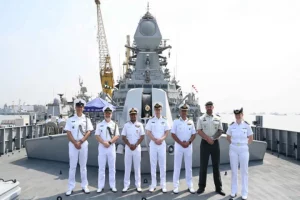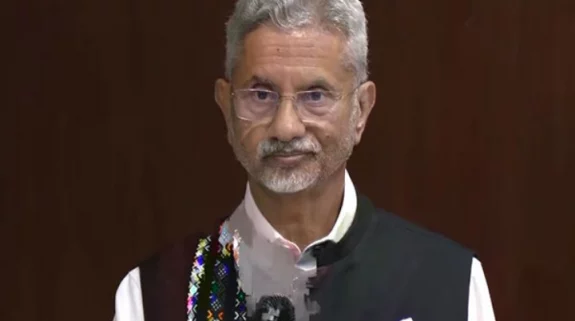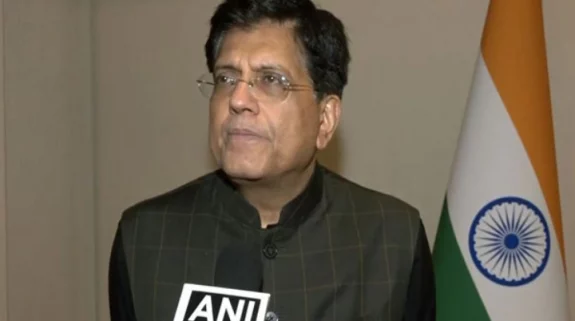Indian Navy has come a long way since December 4, 1971, when, during Operation Trident in the 1971 Indo-Pak war, it sunk many Pakistani ships, struck the enemy harbour and demolished oil and shore defence installations at the Karachi port. It is to commemorate this successful naval action that Navy Day is celebrated on December 4, every year. The ‘Combat Ready, Credible and Cohesive’ Indian Navy has not only grown stronger in the new millennium but is now looking to compete with the best in the Indian Ocean Region (IOR).
With the Navy Chief Karambir Singh <a href="https://indianarrative.com/india/indian-navy-third-aircraft-carrier-will-be-key-to-meet-5-trillion-dollar-economy-goal-navy-chief-34547.html">making a strong pitch</a> for a third aircraft carrier and bolstering its aviation arm, procurement and induction of more key assets, including more submarines, would only strengthen Indian Navy's dominance in the coming times.
Senior Indian Navy officers have stressed over the past few years how policy reforms by the government, such as the Strategic Partnership Model and the Technology Development Fund, have emerged as catalysts for the Navy’s goal of self-reliance. Under the Indian Navy's 'Make in India' and 'Atmanirbhar Bharat' initiative, dozens of ships are under construction in Indian shipyards. Even though there's still a long way to go, with long-term budgetary support required to build the Naval capability, slowly but steadily, Indian Navy’s 2012-27 Maritime Capability Perspective Plan (MCPP) is taking shape.
<img class="alignnone size-full wp-image-35182" src="https://indianarrative.com/wp-content/uploads/2020/12/Indian-Navy-Day-2020.jpg" alt="Indian Navy Day " />
Last month, India's fifth Scorpene submarine of Project-75 named ‘Vagir’was launched at Mazagon Dock Shipbuilders Limited (MDL) in Mumbai. Two submarines of the programme, Kalvari and Khanderi, have already been commissioned into the Indian Navy. The third submarine, Karanj, is in the last phase of rigorous sea trials. The fourth Scorpene, Vela, has commenced her sea trials, whilst the sixth and last submarine, Vagsheer, is being readied for boot together. The Scorpene project is given support by the Department of Defence Production (MoD) and Indian Navy throughout its various phases of construction.
According the defence ministry, the state-of-the-art technology utilized in the rebuilt Scorpene – Vaagir was decommissioned in 2001 after nearly three decades of service to the nation – has ensured superior stealth features (such as advanced acoustic absorption techniques, low radiated noise levels, hydro-dynamically optimised shape) and the ability to launch an attack on the enemy using precision guided weapons. The attack can be launched with both torpedoes and tube launched anti-ship missiles, whilst underwater or on surface. The stealth of this potent platform is enhanced by the special attention provided to her characteristic underwater signatures.
On October 22, the last of four indigenously built Anti-Submarine Warfare (ASW) stealth corvettes 'INS Kavaratti' under Project 28 (Kamorta class) was commissioned into the Indian Navy by Indian Army chief General Manoj Mukund Naravane at the Naval Dockyard in Visakhapatnam.
Touted as a potent Stealth ASW Corvette, Kavaratti is indigenously designed by the Indian Navy's in-house organisation, Directorate of Naval Design (DND), and built by Garden Reach Shipbuilders & Engineers (GRSE), Kolkata. It portrays the growing capability of the Indian Navy, GRSE and the nation in becoming self-reliant through indigenization.
As per the Indian Navy, the ship has up to 90 per cent indigenous content and the use of carbon composites for the superstructure is a commendable feat achieved in Indian shipbuilding. The ship’s weapons and sensors suite is predominantly indigenous and showcases the nation’s growing capability in this niche area.
"Kavaratti has a state-of-the-art weapons and sensor suite capable of detecting and prosecuting submarines. In addition to its anti-submarine warfare capability, the ship also has a credible self defence capability and good endurance for long-range deployments," said the government while elaborating how the induction of Kavaratti into its fold will enhance the Indian Navy’s preparedness manifold.
The ship, which takes its name from erstwhile INS Kavaratti which was an Arnala class missile corvette, has been commissioned as a combat-ready platform after completing sea trials of all the systems fitted onboard.
Earlier in July, the Anti-Submarine Warfare capability of the Indian Navy had received a major boost with the induction of Advanced Torpedo Decoy System 'Maareech' capable of being fired from all frontline warships. "The prototype of this system installed onboard a nominated naval platform had successfully completed all user evaluation trials and demonstrated the features as per the Naval Staff Qualification Requirements," said the Indian Navy.
<img class="alignnone size-large wp-image-35191" src="https://indianarrative.com/wp-content/uploads/2020/12/Indian-Navy-Day-1-1024×605.jpg" alt="Indian Navy Day " />
Another game-changer technology in the Anti-Submarine Warfare, Supersonic Missile Assisted Release of Torpedo (SMART) was successfully flight tested on October 5 from Wheeler Island, off the coast of Odisha. SMART is a missile-assisted release of lightweight Anti-Submarine Torpedo System for Anti-Submarine Warfare (ASW) operations far beyond torpedo range and significant in boosting Anti-Submarine warfare capabilities. A number of DRDO laboratories including DRDL, RCI Hyderabad, ADRDE Agra, NSTL Visakhapatnam have developed the technologies required for SMART.
As part of the 'Atma Nirbhar Week' celebration in August, Defence Minister Rajnath Singh had assured of taking more steps towards, indigenisation, investment in defence infrastructure and expansion in defence manufacturing capability. “The ban on imports of 101 items is a big step towards an Atma Nirbhar Bharat. This list of negative items contains not only small items but weapon systems of high and critical technology. More such items will be added to this list shortly which will save crores of rupees in imports,” he said.
Meanwhile, major structural and outfitting work of under-construction Indigenous Aircraft Carrier (IAC) at Cochin Shipyard has been completed. Ship’s targeted delivery was affected due to delay in supply of aviation equipment from Russia and also the Covid-19 pandemic. Indian Navy acquires various ships/weapons/equipment including the carrier-based Aircraft in accordance with the MCPP and Long Term Integrated Perspective Plan (LTIPP). The sea trials of IAC are expected in the first half of next year, followed by the flight operations.
"By the end of next year (2021) or maybe by early 2022 she will be definitely commissioned," Vice Admiral Anil Kumar Chawla, Flag Officer Commanding-in-Chief, Southern Naval Command, said on Wednesday.
Change is also being witnessed on other fronts. History was made when the first batch of women pilots of Indian Navy were operationalized on Dornier Aircraft by the Southern Naval Command (SNC) at Kochi.
The three women pilots were part of the six pilots of the 27th Dornier Operational Flying Training (DOFT) Course, who graduated as ‘Fully operational Maritime Reconnaissance (MR) Pilots’ at a passing out ceremony held at INS Garuda, Kochi on 22 October 2020..




















